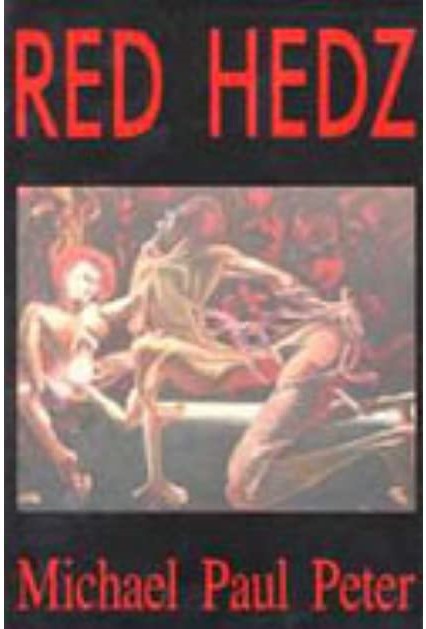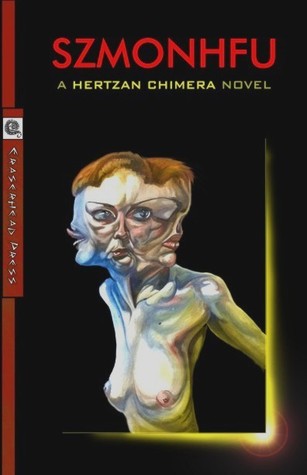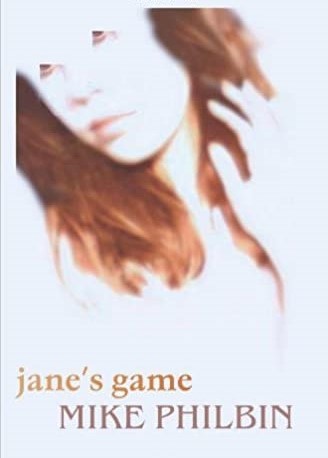In the already legendary 2020 film study THE BROOD, author Stephen Bissette writes of the popular manga TOMIE that there is “nothing in Western horror literature, cinema and comics quite like it.” Not unless you take into account the 1989 novella RED HEDZ, which was revised as SZMONHFU, and again as JANE’S GAME.
TOMIE, written and illustrated by Junji Ito, is a horrific depiction of a shape-shifting woman who seduces unsuspecting men and can regenerate starfish-like from her own cut-off limbs (dismemberment being something that occurs quite often in the TOMIE saga). Similar powers are possessed by Jane, the heroine of the three novels under discussion, which represent something unique in genre literature: a twice revised book that exists under three separate titles and just as many credited authors. RED HEDZ by “Michael Paul Peter” appeared first in 1989, followed by SZMONHFU by “Hertzan Chimera” in 2001, and JANE’S GAME by Mike Philbin (the author’s real name) in 2006; in subsequent years JANE’S GAME, for the record, had its authorial credit switched to Chimera, while RED HEDZ seems destined to remain out of print for the remainder of eternity.
 Readers of Philbin/Chimera novels like BUKKAKEWORLD, about a world clotted with seminal fluid, and PLANET OF THE OWLS, about gods arriving on Earth in the guise of birds (and also the “Michael Paul Peter” gross-out extravaganza “Vixen-Naked Ultra-Luncheon,” found in the anthology RED STAINS), will know what to expect from RED HEDZ, Philbin’s first novel. Based on a painting of the same name that adorns the book’s cover, it was written, he claims, to “get my art onto the covers of books.” Philbin was partially successful in his aims, as he ended up illustrating RAISM, a prose poem written by James Williamson (as “James Havoc”), of the late Creation Press (whose second or third publication RED HEDZ was).
Readers of Philbin/Chimera novels like BUKKAKEWORLD, about a world clotted with seminal fluid, and PLANET OF THE OWLS, about gods arriving on Earth in the guise of birds (and also the “Michael Paul Peter” gross-out extravaganza “Vixen-Naked Ultra-Luncheon,” found in the anthology RED STAINS), will know what to expect from RED HEDZ, Philbin’s first novel. Based on a painting of the same name that adorns the book’s cover, it was written, he claims, to “get my art onto the covers of books.” Philbin was partially successful in his aims, as he ended up illustrating RAISM, a prose poem written by James Williamson (as “James Havoc”), of the late Creation Press (whose second or third publication RED HEDZ was).
That the author’s orientation was in the visual arena is evident in the cinematic bent of RED HEDZ, which, as a blurb from NEKROMANTIK director Jorg Buttgereit states, would make for “a perfect Cronenberg movie.” Cronenberg is indeed a good reference point, has are the paintings of H.R. Giger and the Japanese GUINEA PIG series entry “Mermaid in A Manhole,” all of which are directly recalled in imagery that’s relentlessly gruesome, indeed ground-breakingly so for 1990.
Peter/Philbin’s prose initially takes some getting used to, being labored, self-conscious and oftentimes grouped into pseudo-poetic stanzas. Yet the slim narrative presents a gripping vortex of twisted love, bloodletting and mutation, with the surreal artist Paul Kasparek, a Londoner who’s just been dumped by his girlfriend Susan, finding love (of a sort) in the form of Jane, a red headed seductress who inexplicably turns up in his studio one day.
That things are going to get nasty is foreshadowed by the opening chapter, consisting of a news report about gruesome findings in Paul’s flat: “Innards. Feces. The stench was horrendous. Sickening…a domestic…abattoir.” What follows is an extended flashback showing how things got to that point, with a perverse-to-begin-with relationship growing increasingly violent and depraved. Jane, it transpires, is a projection of her lover’s unsettled subconscious, and capable of changing her form at will (from the guise of Susan to her own self with razor blades embedded in her skin).
Like the abovementioned Tomie, Jane functions as a succubus who destroys her mate by inflaming both his passions and his psychosis–with evisceration and cannibalism eventually coming into play—and also as a conduit for her twenty year old creator’s anxieties about the opposite sex. Under Jane’s spell Paul himself undergoes a fair amount of biological morphing, growing a vagina at one point (while Jane sprouts a penis). This is psychosexual insanity of an extremely high order, and concludes just as all the sex, violence and transmutations threaten to become repetitive.
Flash forward twelve years to the publication of SZMONHFU, the first of Mike Philbin’s RED HEDZ reworkings. A much longer book than  RED HEDZ, it brings back Jane, who here becomes the protagonist. She’s no longer a shape-shifting subconscious construct, as according to a preamble by Philbin, “the narrative was redirected to follow her quest to find the Holy Grail of identity in a Universe devoid of morals.” The Jane of SZMONHFU is an amnesiac supermodel, and Paul has become Paul Kansaii, a Japanese immigrant who is otherwise identical in outlook and background to Paul Kasparek.
RED HEDZ, it brings back Jane, who here becomes the protagonist. She’s no longer a shape-shifting subconscious construct, as according to a preamble by Philbin, “the narrative was redirected to follow her quest to find the Holy Grail of identity in a Universe devoid of morals.” The Jane of SZMONHFU is an amnesiac supermodel, and Paul has become Paul Kansaii, a Japanese immigrant who is otherwise identical in outlook and background to Paul Kasparek.
The narrative this new Paul finds himself caught up in, which takes up much of SZMONHFU’S first 60 pages, is likewise quite similar to that of the earlier book, with Jane “slowly assimilating him into her personality. The way she moved. The phrases she came out with from time to time. The glib range of commentary vocabulary Paul coveted as his very own was siphoned from him as insidious as cellular osmosis.” Here, though, the Jane-Paul relationship is cut short before any of the outrageous body morphing and bloodletting of the earlier book can occur, with Jane killing Paul and taking off.
She shacks up with Dave, a loutish truck driver with whom she finds happiness (of a sort). Like Paul, though, Dave isn’t long for this world, being dismembered by a band of toughs that Jane is able to fight off and dispatch with shocking ease. The reason for her superhuman capabilities? She’s part, we learn, of an alien race known as Szmonhfu who secretly control the Earth—and at this point the novel goes mad, with Jane relegated to supporting character status as the narrative grows increasingly disjointed and incoherent (think Philip K. Dick and William S. Burroughs tossed into a blender), and James Doray, a Szmonhfu curated rock star who isn’t introduced until the novel’s second half, inexplicably taking center stage.
 Thankfully the fat is trimmed back in Philbin’s second RED HEDZ redo JANE’S GAME. Here Jane is made the subject of a biological research experiment carried out by an organization known as the Fountain Institute, with the alien invasion narrative of SZMONHFU thankfully left out (it appears to have been integrated into 2013’s THE HOO HOO ARE COMING). Before learning of Jane’s origins, though, we’re once again presented with a recounting of the events of RED HEDZ, with the character of Paul returned to his initial guise of Paul Kasparek, a Brit. Much more of RED HEDZ is included here than was in SZMONHFU, and Philbin even returns to it in JANE’S GAME’S time tripping final pages.
Thankfully the fat is trimmed back in Philbin’s second RED HEDZ redo JANE’S GAME. Here Jane is made the subject of a biological research experiment carried out by an organization known as the Fountain Institute, with the alien invasion narrative of SZMONHFU thankfully left out (it appears to have been integrated into 2013’s THE HOO HOO ARE COMING). Before learning of Jane’s origins, though, we’re once again presented with a recounting of the events of RED HEDZ, with the character of Paul returned to his initial guise of Paul Kasparek, a Brit. Much more of RED HEDZ is included here than was in SZMONHFU, and Philbin even returns to it in JANE’S GAME’S time tripping final pages.
Also back is Dave the truck driver, whose appearance, background and ultimate fate are identical to what was described in SZMONHFU. New to JANE’S GAME is a passage in which Jane pays a visit to her estranged parents, and some espionage that gives the proceedings a very GIRL WITH ALL THE GIFTS flavor.
Two like-minded sequels followed JANE’S GAME: TWILIGHT’S LAST GLEAMING and THE HOO HOO ARE COMING, which taken together apparently form a trilogy. The main problem with the latter two books, from what I can see, is that Jane, the most compelling component of JANE’S GAME and its predecessors, doesn’t figure very heavily in either. Another damning fact is that the best novel mentioned in this survey was and remains RED HEDZ, which despite its excess and misogyny is every bit the “hardcore horror classic” it was cracked up to be.
